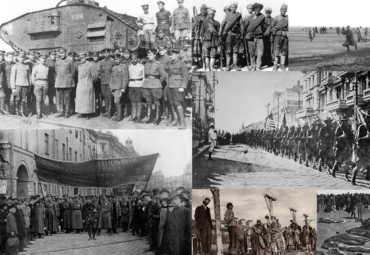User:Wiki the Octopus/Sandbox/Correct Russian Civil War infobox
(Redirected from User:Wiki the Octopus/sandbox)
- ^ Polish–Lithuanian War
- ^ Red Army invasion of Armenia
- ^ Allegiance to the Russian State between 3 January 1919 and February 1920. See Russian Army (1919).
- ^ Japan also stayed in North Sakhalin until 1925.
- ^ Supported Bolsheviks against Finnish-backed Karelians during the Viena expedition
- ^ The Allies also supported Pro-Allied separatists when Central Powers supported the White Movement
- ^ Briefly was a Central Power (February-April 1918)
- ^ Fought a war with Poland before they became allies
- ^ Opposed to White Army
- ^ Created as a Central Power puppet state that later became pro-allied
- ^ Allied-backed when assisting Estonians, Central Power when assisting Karelians and Ingrians. See Heimosodat
- ^ Some pro-Allied separatists saw the Bolsheviks as a bigger threat than the White Army, while some were opposed to both. Sometimes Central Powers supported various White movements that were opposed to separatism (particularly the Don Republic, the Kuban People's Republic and the West Russian Volunteer Army)
- ^ Finnish Civil War
- ^ Polish-Soviet War
- ^ Basmachi movement
- ^ Basmachi movement
- ^ Basmachi movement
- ^ De facto deposed after the Bolshevik Coup of November 1917; formally abolished in January 1918 after the dissolution of the Constituent Assembly. The White movement then promised to convey a new constituent assembly and reestablish the state accordingly with its decisions.
- ^ Anti-Bolshevik soviets and Assemblies of Workers' Plenipotentiaries
- ^ Came close to war with the Siberian Army
- ^ Created as a Central Power puppet state that later became pro-allied
- ^ Aligned with the Bolsheviks until March 1918, when they fell out over the Treaty of Brest-Litovsk. Most Left SRs opposed the Bolsheviks afterward, but a minority of Left SRs remained allied to the Bolsheviks for years after.
- ^ Intermittently aligned with the Bolsheviks until 1920; opposed after.
- ^ Aligned with the Bolsheviks until 1919; opposed after.
- ^ The evacuation of Crimea was the end of major resistance to the Bolsheviks (apart from the Green Army revolts which occurred mostly in 1921-22), while the main phase ended on 25 October 1922. However, lower-scale revolts against the Bolsheviks continued in Central Asia and the Far East through the 1920s and 1930s. As a result, the earliest start date for the civil war is 7 November 1917 and the latest date for the end of the civil war being the 16 June 1923.
- ^ The Red Army peaked in October 1920 with 5,498,000: 2,587,000 in reserves, 391,000 in labor armies, 159,000 on the front and 1,780,000 drawing rations
- ^ 683,000 active
340,000 reserve - ^ Not always allied with White Army
- ^ Official allegiance to the Russian State
Unofficial allegiance to the German Empire - ^ Came close to war with the Siberian Army
- ^ Mawdsley, Evan (2007). The Russian Civil War. New York: Pegasus Books. ISBN 9781681770093.
- ^ Последние бои на Дальнем Востоке. М., Центрполиграф, 2005.
- ^ Erickson 1984, p. 763.
- ^ Damien Wright, Churchill's Secret War with Lenin: British and Commonwealth Military Intervention in the Russian Civil War, 1918–20, Solihull, UK, 2017, pp. 394, 526–528, 530–535; Clifford Kinvig, Churchill's Crusade: The British Invasion of Russia 1918–1920, London 2006, ISBN 1-85285-477-4, p. 297; Timothy Winegard, The First World Oil War, University of Toronto Press (2016), p. 229
- ^ Belash, Victor & Belash, Aleksandr, Dorogi Nestora Makhno, p. 340
- ^ a b Smele 2016, p. 160.
- ^ Wright, Damien (2017). Churchill's Secret War with Lenin: British and Commonwealth Military Intervention in the Russian Civil War, 1918–20'. Solihull, UK: Helion and Company. pp. 490–492, 498–500, 504. ISBN 978-1911512103.; Kinvig 2006, pp. 289, 315; Winegard, Timothy (2016). The First World Oil War. University of Toronto Press. p. 208.
- ^ Eidintas, Žalys & Senn 1999, p. 30.
